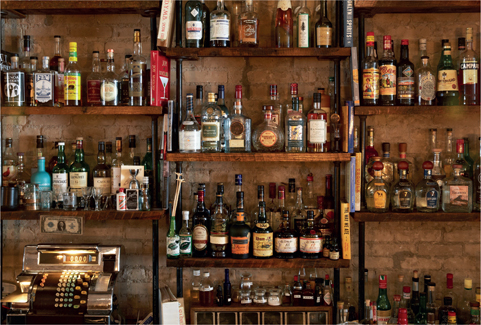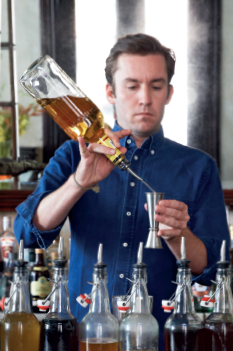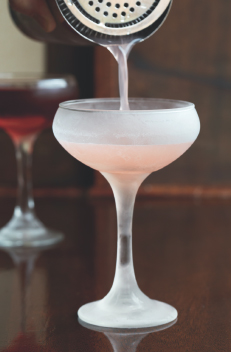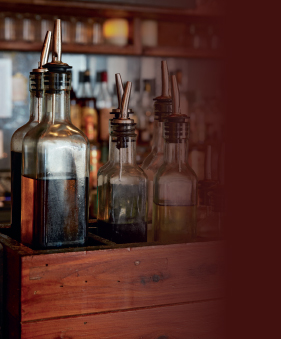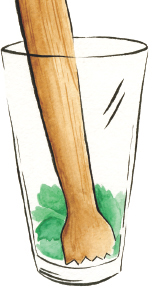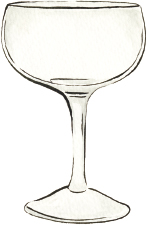INGREDIENTS
10 ESSENTIAL BOTTLES
VODKA
The ultimate blank canvas for flavors, and still the liquor of choice for many. Once you’re above the true bottom shelf, most expensive vodkas get their sticker price through marketing, rather than quality. Wodka vodka is a real value; Russian Standard and Tito’s are two other favorites.
GIN
The juniper-flavored spirit stars in classic cocktails and 21st-century creations alike. Tanqueray and Beefeater are both excellent, time-tested gins in the classic London Dry style; Plymouth, a little pricier but favored by many bartenders; Greenhall’s, a great value. (And if you want to be truly Brooklyn, grab a bottle of local Brooklyn Gin or Dorothy Parker.)
LIGHT RUM
Another clear spirit, white rum integrates beautifully with many flavors, and is versatile far beyond its usual uses in mojitos and daiquiris. Brugal Extra Dry will shine in any light rum cocktails, as will Banks 5 Year or El Dorado 3 Year.
BLANCO TEQUILA
Silver tequila is best known for margaritas but has any number of other uses in the cocktail world. Look for the designation “100% agave” when picking out a bottle. Pueblo Viejo and Espolón are widely available and a good value.
BOURBON
American-made and often a touch sweeter than its fellow whiskeys, bourbon is endlessly friendly for mixing. Evan Williams Black Label is an unbeatable value, and Old Grand-Dad, similar. Old Forester is a classic, if slightly pricier, bourbon for those new to the genre.
RYE
Generally spicier and drier than bourbon, rye is the spirit of choice for many bartenders when making classic cocktails—Old Fashioneds and Manhattans among them. Rye is the rare category where there’s a true consensus on value and quality; Rittenhouse and Old Overholt are almost universal favorites.
SWEET VERMOUTH
The aromatized wine is essential to Manhattans, Negronis, and every variation thereof. Keep it refrigerated; vermouth is wine-based and will go off just as an open bottle of wine would (if more slowly). Virtually every craft cocktail bartender today will recommend Carpano Antica Formula sweet vermouth; it’s a bit pricier than others, so seek out a 375-mL for your first bottle.
DRY VERMOUTH
As essential in the mixology world as its sweeter, darker counterpart. This, too, must be refrigerated once opened. Dolin Dry is an excellent choice here; if it’s not available where you are, Noilly Prat is a good alternative.
Tooker Alley
ORANGE LIQUEUR
From the margarita to the Sidecar, orange liqueur is indispensable; Cointreau is your best bet for a versatile midpriced bottle; dry Curaçao is another favorite.
ANGOSTURA BITTERS
When there’s just a dash of bitters in any given drink, they may seem optional, but that dash is critical to balance out a cocktail—and when used with a little more gusto, Angostura (or as the pros often call it, Ango) contributes an intriguing element of warm, earthy spice.
… AND 10 MORE
COGNAC
In pre-Prohibition days, brandy was the base spirit of choice for many classic cocktails, and smooth, aged Cognac was considered the best of all. The very word Cognac connotes a luxury product, and its price tag is why Cognac cocktails are somewhat rare today; but several houses have released moderately priced, cocktail-friendly bottles developed for mixologists; look for H by Hine or Pierre Ferrand 1840.
BLENDED SCOTCH
While many drinkers sip their Scotch neat or, at the most, with a splash of water, blended Scotches form the base of many excellent cocktails. The Famous Grouse is widely available and a good value.
Hotel Delmano
DARK RUM
Whereas white rum disappears seamlessly into many cocktails, longer-aged rums have a robust, often whiskey-like character all their own. Diplomático Reserva, Ron Zacapa Centenario, and El Dorado 12-Year are all good bets.
REPOSADO TEQUILA
Reposado translates to “rested”; reposado tequila is a lightly aged spirit, “rested” in barrels for up to one year, that’s a bit smoother and weightier than its lighter-colored counterparts. Pueblo Viejo is a real value.
MEZCAL
Known to only the most devoted of liquor nerds a few years ago, mezcal is now a bartender favorite across the country. Like tequila, it’s a spirit made from agave, but it has a distinct, smoky character. Fidencio Mezcal and Del Maguey Vida are both highly recommended.
IRISH WHISKEY
American-made bourbon and rye are a great start, but Irish whiskey, generally on the lighter and sweeter side, also shines in cocktails. There’s nothing wrong with fallback Jameson, though Tullamore D.E.W. is a better value.
CAMPARI
Bright red and utterly unique, this bittersweet amaro stars in classic cocktails (you can’t make a Negroni without it!) and any number of bartenders’ newer creations.
APEROL
A close cousin of Campari, Aperol is lighter and less bitter, with a compelling orange flavor that brightens many a modern cocktail. (Like Campari, Aperol is a distinct product, rather than a category; there’s only one Aperol. Ditto St-Germain, Chartreuse, and Fernet-Branca, to follow.)
MARASCHINO
Not the neon-red liquid in the cherry jar, but a sophisticated cherry-based liqueur that plays a part in many classics. Luxardo maraschino is the gold standard.
ORANGE BITTERS
Between orange and Angostura bitters, you’ll have the finishing touch for a huge number of cocktails. (Many companies make orange bitters, including Angostura’s orange, which will be the most widely available; Regan’s orange bitters are a favorite.)
AND A FEW MORE FOR FUN…
APPLEJACK
A barrel-aged apple brandy, considered by many to be the “original” American spirit (George Washington was among its fans). It drinks like a slightly sweeter whiskey with a distinct apple character. Laird’s is the first—and still the best—producer; their “Bottled in Bond” is the applejack to get, made from nothing but apples.
ST-GERMAIN
A brand of sweet elderflower liqueur that’s become tremendously popular in recent years.
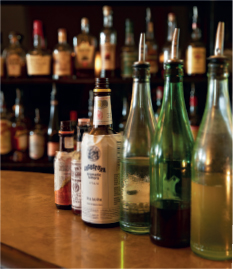
Bitters at The Narrows
FERNET BRANCA
Powerfully bitter and herbal, verging on the medicinal, Fernet is the darling of 21st-century bartenders; it’s an acquired taste, to put it mildly.
CHARTREUSE
A distinctive liqueur made by French Carthusian monks since the 18th century. Green Chartreuse is higher-proof and more strongly herbal; yellow Chartreuse, mellower and sweeter, appears more often in cocktails.
PAMPLEMOUSSE
Like fashion or music, cocktails go through trends, and right now this grapefruit liqueur is popping its head up everywhere. Combier is an excellent brand.
AND A FEW MORE BITTERS, ETC.…
While Angostura and orange bitters will get you far, today’s bartenders have dozens, if not hundreds, more to choose from. If you’ve got room for one more bottle, go with the bright red Peychaud’s, with a distinctive anise character, which often appears in classics. Beyond that? Nearly across the board, Brooklyn bartenders love Bittermens Very Small Batch bitters; in this book, you’ll find many recipes that use their Xocolatl Mole bitters, inspired by Mexican mole sauces and flavored with cacao, cinnamon, and spice; the Hellfire Habanero Shrub is a favorite for delivering heat, and the Hopped Grapefruit bitters, a distinctive citrus bitters with vegetal bitterness from hops.
ON SWEETENERS
“I want a cocktail that’s not too sweet”; or, “I want this drink, but without simple syrup.” Bartenders might hear some version of this every time they’re behind the stick. And there are any number of reasons that drinkers are wary of sugar. Up until recently, your average cocktail, made with corn syrup–laden mixers and sugar-filled juices, tended to be very sweet; in most cases, overly so. These drinks turned plenty of would-be drinkers off cocktails altogether. (Calorie-counting plays a role too, although here’s a tip: If you’re concerned about calories in cocktails, they’re not coming from that quarter-ounce of simple syrup. They’re coming from the alcohol.)
“When people say not too sweet—and it happens all the time—there’s a bigger conversation we can have… What does that mean to you?”
—Liz Stauber, The Narrows
That said, sweeteners are essential in cocktails. Every well-constructed drink is designed with an eye toward balance—not too spirituous, not too bitter, not too acidic—every flavor in proportion. Taking out the sweetener is like removing one leg from a four-legged stool; the whole thing falls down. Suddenly the sour and bitter and boozy elements are all out of whack. Some cocktails, of course, are sweeter than others, and some drinkers prefer cocktails that are sweeter than others. Plenty of drinks are intended to be powerfully bitter, or spirit-forward, or tart. But it’s essential to try a recipe as written, rather than cutting back on the sugar right off the bat. Just as salt in a recipe doesn’t necessarily make the dish salty, a sparing amount of sugar doesn’t have to make it sweet.
When bartending at home, accept that some sweetener is essential to any cocktail—but beyond that it is a matter of preference. “When people say not too sweet—and it happens all the time—there’s a bigger conversation we can have,” says Liz Stauber of The Narrows in Bushwick. “What does that mean to you? Did you have a terrible Old Fashioned, where they opened packets of sugar and muddled that with maraschino cherries? Or are you saying that you like something dry and spirit-forward?” There’s a cocktail suited to every taste—but regardless of the ingredients, balance is key.
The Improved Pendennis Club Cocktail, Long Island Bar
SIMPLE SYRUP
While simple syrup isn’t the only way to sweeten a cocktail, it’s by far the most common. Whereas putting granulated sugar straight into a drink will result in gritty sugar grains left behind, simple syrup—which is nothing more than white sugar dissolved in an equal amount of hot water—already has the sugar in solution, so it integrates seamlessly.
These days, you’ll see simple syrup sold, premade, in supermarkets and gourmet shops. It’s a brilliant marketing scheme if ever there were one—combine sugar and water, sell at an obscene markup!—but a huge waste of money and packaging; making simple syrup is as easy, and as quick, as boiling water.
TO MAKE SIMPLE SYRUP
Start with equal parts white sugar and hot water (whether from a kettle, heated in the microwave, or straight from a very hot tap). Stir together until the sugar disappears and the solution is clear. Store in the refrigerator.
… AND OTHERS
Rich simple syrup, two parts sugar to one part water, is preferred by some bartenders, as it contributes less water to a cocktail for a given amount of sugar. You’ll also find recipes calling for demerara syrup, made with richer, more flavorful demerara sugar; agave syrup, well-suited to tequila and mezcal drinks, two spirits that are themselves distilled from agave; and honey and maple syrup, each a bit richer in body than simple syrup and, of course, each contributing a distinctive flavor.
Recipes without any syrups at all will generally have some other sweet element, whether vermouth, a liqueur like Cointreau or maraschino, or fresh fruit.
RECIPE NOTE ON SYRUP SPECS
Some bartenders make their honey syrup with equal parts honey and hot water, others 2:1 or 3:1; ditto agave, demerara, and more. For all sweeteners other than simple syrup, the ratio of sweetener to water will be noted in parentheses.
Examples: Rich simple syrup (2:1) denotes 2 parts sugar dissolved in 1 part water; honey syrup (3:1), 3 parts honey to 1 part water; demerara syrup (1:1), equal parts.
ON CITRUS
If there’s a single, indisputable rule for making the best cocktails, it might be this: Use fresh juice. Not lime juice from concentrate, not from one of those lime-shaped plastic bottles, but from honest-to-goodness limes, squeezed right before you make your cocktails.
The vibrancy and flavor of fresh juice just can’t be matched. Citrus juice is perishable, so best used the day it’s squeezed. With your trusty hand juicer, making juice won’t take more than a minute, and the results will speak for themselves.
EQUIPMENT
As with any craft, proper tools are essential to bartending. And while the mixologists of today might have all manner of wonky gadgets at their disposal—from centrifuges to carbon dioxide chargers to custom ice machines—the basic equipment you need is simple and inexpensive.
ESSENTIAL EQUIPMENT
SHAKER
While any shaker will work, a set of two metal shaking tins is the industry standard. No caps to lose, easy to clean, almost impossible to break.
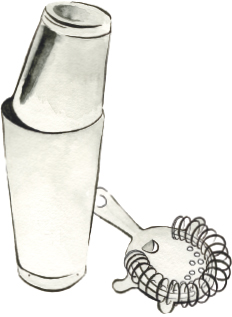
STRAINER
A “Hawthorne” strainer, with a handle and a spring coiled around the front, will fit neatly over your shaking tin, straining out ice as you pour your finished cocktail.
CITRUS JUICER
Fresh citrus juice is essential to a huge percentage of cocktails; a two-handled “beehive” juicer will make quick work of lemons, limes, and more.
MIXING GLASS
While a pint glass will do in a pinch, a proper mixing glass is ideal for stirred cocktails; its volume allows for plenty of ice to chill down the drink.
BAR SPOON
A long-handled bar spoon is designed for stirring cocktails.
JIGGER
What’s the use of a cocktail recipe if you’re not following the specs? Use a jigger to properly measure your ingredients. ¼ oz/10 mL, ½ oz/15 mL, ¾ oz/20 mL, 1 oz/30 mL, and 2 oz/60 mL are the key measurements; make sure that your jigger (or set of jiggers) has these demarcations.
NEXT-LEVEL EQUIPMENT
MUDDLER
A heavy, blunt tool intended for muddling—that is, smashing—tougher fruits, vegetables, and other ingredients.
FINE-MESH STRAINER
For cocktails that require double-straining, generally to remove fine bits of fruit or herbs.
JULEP STRAINER
Generally best for straining out stirred drinks, the julep strainer has a bowl-shaped cup that nestles inside a mixing glass.

SPECIALTY ICE TRAYS
Ice is a key ingredient in every cocktail; high-quality ice trays are worth the investment. 1¼-inch/30-mm cubes are ideal for shaking, while pouring a drink over a single 2- or 2½-inch/70-mm cube (also called “big ice” or “a rock”) is an elegant way to present a cocktail in a rocks glass.
PEELER
A sharp knife will work to cut citrus peels for garnishes, but a Y-shaped peeler makes the job easier.
ESSENTIAL GLASSWARE
COUPE
The quintessential cocktail glass, with a wide bowl and thin stem. Used to serve cocktails “up”—that is, without ice.
ROCKS GLASS
Short and squat, for cocktails “on the rocks” (served with ice). An “old fashioned” glass is a smaller version, while a “double old fashioned” is essentially the same as a rocks glass (capacity is the only difference).
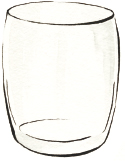
FLUTE
For champagne and many sparkling cocktails.
COLLINS GLASS
Tall and straight-sided, named for the Tom Collins—lemon juice, gin, sugar, and soda—but ideal for any long drink (with a large volume of mixer, like soda or tonic). A highball glass is a slightly smaller version.
NEXT-LEVEL
PINT GLASS
For beer, and for (increasingly popular) beer cocktails.
MARTINI GLASS
While a coupe is an elegant way to present a Martini, some drinkers still prefer the V-shaped Martini glass.
JULEP CUPS
Silver-plated cups, filled to the brim and above with crushed ice, are the only proper way to present a julep. Bonus points for matching metal straws.
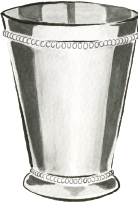
AND MORE…
Bartenders will use capacious hurricane glasses for tiki-style drinks with crushed ice; copper Moscow Mule mugs for the popular vodka–ginger ale drink; and Nick and Nora glasses for up drinks, an elegant vessel looking like something between a coupe and a small wine glass.
